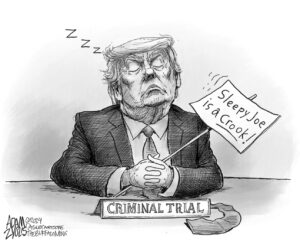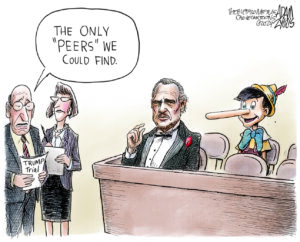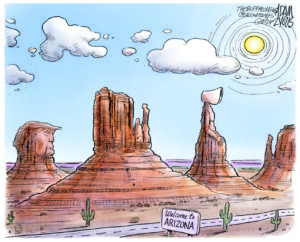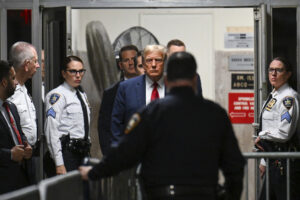North Korea Summit Is Back on Track, Trump Says
"We're going to deal," the president tells reporters after meeting with a top North Korean official who delivered a letter from Kim Jong Un.WASHINGTON—The U.S.-North Korea summit is back on, President Donald Trump announced Friday, ending weeks of uncertainty about a historic meeting with Kim Jong Un, to discuss ending the North Korean leader’s nuclear program.
Trump made the announcement, just a week after he had said he was canceling the Singapore summit, following a more than hour-long meeting with a top North Korean official who delivered a letter from the North Korean leader. The official, Kim Yong Chol, posed for photos with Trump outside the Oval Office, and they talked amiably at Kim’s car before he was driven away.
“We’re going to deal,” Trump told reporters after Kim left. He also said it was likely that more than one meeting would be necessary to bring about his goal of denuclearizing the Korean peninsula but “I think you’re going to have a very positive result in the end. We will see what we will see.”
In the latest sign of hostility cooling down but hopes kept in check, Trump said he’s unilaterally put a hold on new sanctions against the North “until the talks break down.”
“I don’t even want to use the term ‘maximum pressure’ anymore,” Trump added, referencing his preferred term for the punishing U.S. economic sanctions against North Korea.
Trump told reporters he hadn’t yet read the letter from Kim and added with a smile, “I may be in for a big surprise, folks.” But minutes earlier he had described the note as “a very interesting letter,” and teased journalists about revealing its contents.
Plans for the high-stakes sit-down in Singapore had been cast into doubt. Trump suddenly withdrew from the meeting last week, only to announce a day later that it could still get back on track. White House officials cast the roller-coaster public statements as reflective of the hard-nosed negotiation by the two nations.
Three teams of officials in the U.S., Singapore, and the Korean demilitarized zone have been meeting this week on preparations for the summit.
After North Korean officials delivered a series of bellicose statements last month, Trump announced he was withdrawing from the summit with a strongly worded letter. He cited “tremendous anger and open hostility” by Pyongyang but also urged Kim Jong Un to call him. By the next day, he was signaling the event could be back on after a conciliatory response from North Korea.
Trump has refused to publicly acknowledge whether he’s spoken directly with Kim Jong Un ahead of the talks.
Kim Yong Chol was greeted at the White House by chief of staff John Kelly and then whisked into the Oval Office. He is the most senior North Korean to visit in 18 years, a symbolic sign of easing tensions after fears of war escalated amid North Korean nuclear and missile tests last year.
Questions remain about what a deal on the North’s nuclear weapons would look like, though Trump said Friday he believed Kim Jong Un would agree to denuclearization. Despite Kim’s apparent eagerness for a summit with Trump, there are lingering doubts about whether he will fully relinquish his nuclear weapons, which he may see as his only guarantee of survival.
U.S. defense and intelligence officials have repeatedly assessed the North to be on the threshold of having the capability to strike anywhere in the continental U.S. with a nuclear-tipped missile — a capacity that Trump and other U.S. officials have said they would not tolerate.
Kim Yong Chol left his hotel in New York City early Friday for the trip to Washington in a convoy of SUVs. Secretary of State Mike Pompeo, the former CIA chief who has traveled to North Korea and met with Kim Jong Un twice in the past two months, said he believed the country’s leaders are “contemplating a path forward where they can make a strategic shift, one that their country has not been prepared to make before.”
Yet he also said a news conference that difficult work remains including hurdles that may appear to be insurmountable as negotiations progress on the U.S. demand for North Korea’s complete, verifiable and irreversible denuclearization.
“We will push forward to test the proposition that we can achieve that outcome,” he said.
Despite the upbeat messaging in the United States, Kim Jong Un, in a meeting with Russia’s foreign minister on Thursday, complained about the U.S. trying to spread its influence in the region, a comment that may complicate the summit. “As we move to adjust to the political situation in the face of U.S. hegemonism, I am willing to exchange detailed and in-depth opinions with your leadership and hope to do so moving forward,” Kim told Sergey Lavrov.
North Korea’s flurry of diplomatic activity following an increase in nuclear weapons and missile tests in 2017 suggests that Kim is eager for sanctions relief to build his economy and for the international legitimacy a summit with Trump would provide.
Trump views a summit as a legacy-defining opportunity to make a nuclear deal.
Kim Yong Chol is the most senior North Korean visitor to the United States since Vice Marshal Jo Myong Rok visited Washington in 2000 to meet President Bill Clinton and Secretary of State Madeleine Albright. That was the last time the two sides, which are technically at war, attempted to arrange a leadership summit. It was an effort that ultimately failed as Clinton’s time in office ran out, and relations turned sour again after George W. Bush took office in early 2001 with a tough policy on the North.
Kim Yong Chol, vice chairman of the North Korean ruling party’s central committee, was allowed into the United States despite being on a U.S. sanctions list. He was granted special permission to travel outside the New York area in order to meet with the president.
___
Associated Press writers Catherine Lucey in Washington, Christopher Bodeen in Beijing and Matthew Lee in New York contributed.
Your support matters…Independent journalism is under threat and overshadowed by heavily funded mainstream media.
You can help level the playing field. Become a member.
Your tax-deductible contribution keeps us digging beneath the headlines to give you thought-provoking, investigative reporting and analysis that unearths what's really happening- without compromise.
Give today to support our courageous, independent journalists.






You need to be a supporter to comment.
There are currently no responses to this article.
Be the first to respond.